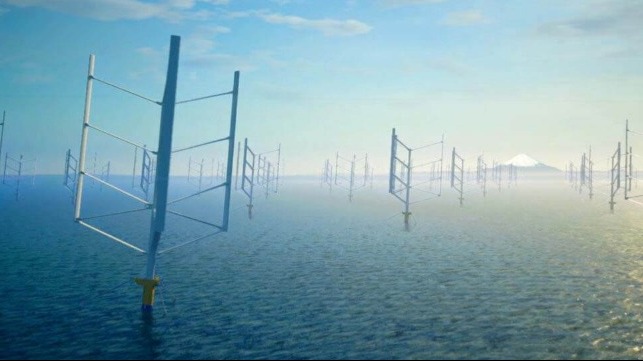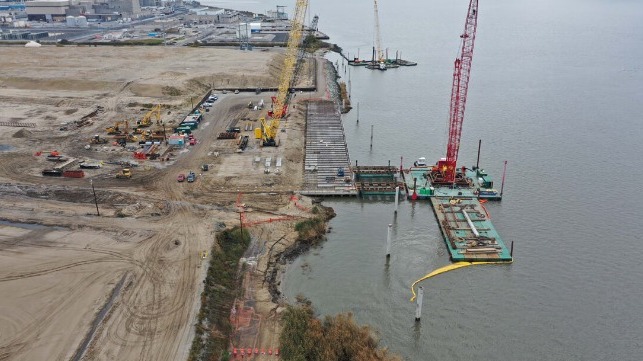Japanese Team Develops “Game Changer” Floating Vertical Axis Wind Turbines

A consortium of Japanese companies is working to develop a new concept in floating offshore wind turbines that they report will be easier to manufacture while also costing less to build and maintain. Known as a vertical axis wind turbine, they believe it will be the next generation technology that will also be well suited to the challenges of floating turbines and resilient to harsh weather conditions.
Conventional horizontal axis floating wind turbines have a high center of gravity which requires a large and expensive to build floating structure to maintain the stability of the turbines, especially in harsh conditions such as a typhoon. The towers stand as high as nearly 500 feet, which the Japanese group highlights increases the maintenance costs. They also point to installation challenges including specialized vessels, and costly port infrastructure for the construction. In addition, the nature of the wind farm makes it difficult to enlarge.
With the vertical axis wind turbine, they report it is possible to increase the power generation to achieve a cost reduction for the overall installation and ongoing operation and maintenance expenses. The concept uses a series of smaller paddles, a maximum height of approximately 360 feet that are closer to the surface and critically have the ability to tilt up to 20 degrees while maintaining output. It uses a rotating cylindrical floating foundation.
The blades would be produced through a continuous pultrusion method using a molding process to form composite materials with carbon-reinforced plastics. The blades are produced in lengthwise sections with the same cross-sectional shape, eliminating the need for large manufacturing facilities. They would also be easier to transport than the traditional large wind turbine blades.
Japan’s J-Power, Osaka University’s Graduate School of Engineering, and Albatross Technology, a company developing ocean renewable energy technologies including floating offshore wind turbines, marine current turbines, and wave energy converters, conducted the initial studies on this floating wind technology. In the next phase, shipping company Kawasaki Kisen Kaisha (“K” Line) will join the research along with Tokyo Electric Power and Chubu Electric Power.
The five partners plan to jointly develop a small-scale (20kW) experimental floating axis wind turbine that will be installed in Japanese waters. After confirming the validity of the analysis and design method, they plan to proceed to a larger scale (megawatt class) offshore demonstration project.
They believe this design concept will represent a “game changer” for the industry and can help to address the challenges that offshore wind faces in Japan and elsewhere. They highlight that while the Sea of Japan is similar in size to the North Sea, which has become the center of Europe’s offshore wind industry, the Seto Inland Sea has a deeper water depth. They point out that moving even a few kilometers from land in Japan, it is difficult to install wind turbines with fixed foundations.
They also highlight Japan’s exposure to harsh weather and sea conditions including typhoons. This technology they report is designed to maintain its maximum output even with a tilt which they believe means it can significantly contribute to Japan’s future energy needs.
Orsted Signs First Lease for Staging Area at NJ Offshore Wind Port

Orsted has signed the first sublet agreement for space at the New Jersey Offshore Wind Port, a newly-developed heavy lift port site for staging offshore wind turbines for installation.
Orsted will rent 34 acres at the port site and will employ up to 200 people there over the span of its two-year, $25 million lease. The site will support Orsted's massive Ocean Wind 1 project.
“Ørsted’s decision to marshal its Ocean Wind 1 project from the New Jersey Wind Port will create 200 jobs that would otherwise have gone to other states, and is the first of many projects that will use the Port in the years and decades ahead," said New Jersey Economic Development Authority (NJEDA) CEO Tim Sullivan in a statement.
The agreement finalizes a long-anticipated lease deal. Orsted first submitted a non-binding offer to sublet in December 2020, and it agreed to a more formal letter of intent in April 2022. The two parties have been discussing terms for the past year and have settled on a final value for the lease.
Ocean Wind 1 is a large offshore wind farm proposal located about 13 nautical miles off the coast of Middle Township, New Jersey, towards the state's southernmost tip. At full buildout it will have a capacity of 2.2 GW, making it the largest offshore wind farm in the United States and the largest producer of wind power (onshore or off) in New Jersey.
The project was a joint venture between Orsted and New Jersey utility company PSEG until January, when PSEG sold its 25 percent stake and the development became solely owned by Orsted.
The Bureau of Ocean Energy Management (BOEM) approved Ocean Wind 1's construction and operations plan earlier this month, clearing away the final permitting hurdle before putting steel in the water.
Just after the federal approval, the state of New Jersey enacted legislation that will allow Orsted to keep tax credits that would have been passed along to ratepayers. The new law improves the project's financial footing but raising costs for the consumer, and has attracted controversy - and at least one lawsuit.
“If we don't figure out a solution, this doesn't get done in New Jersey,” Gov. Phil Murphy told media after a signing ceremony July 6. “We know war in Europe, inflation, supply chain — these projects have gotten a lot more expensive, and we're not the only place that's dealing with that. Either we get this bill done and the industry thrives here, and the jobs that are associated with it, or it goes somewhere else.”
No comments:
Post a Comment